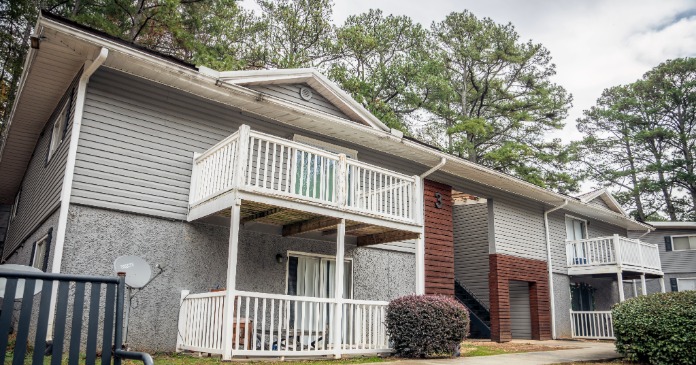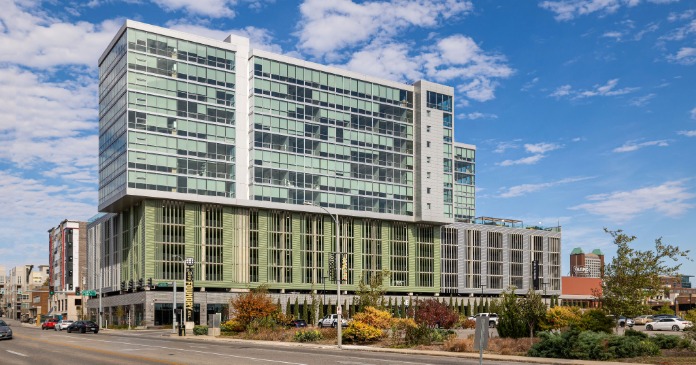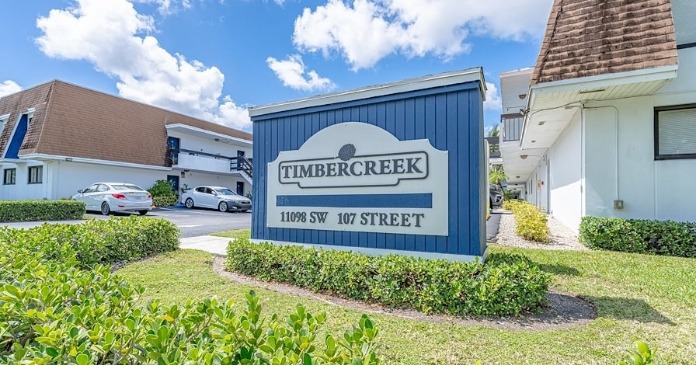“It’s a great time to own apartments on the West Coast,” said Essex President and CEO Michael Schall during his company’s presentation at the Citiglobal Property CEO conference held this March in Hollywood, Fla., where he updated attendees on the integration process underway at his company since the merger closed in April.
Essex has been enjoying the favorable fundamentals of the high-barrier-to-entry West Coast since 1971.
Those markets boast some of the strongest rent growth in the nation, a two-to-one demand-over-supply ratio for housing and expensive single-family homes that make it difficult for people to transition from renter to homeowner.
“The technology field, the great weather, the job base, the high income areas near great schools that tend to generate high-income potential employees—these themes have drawn us to the West Coast, where, for the fifth year in a row, housing demand has outpaced supply, pushing rents higher as market occupancy levels increase,” said Schall.
Over the next five years, more than 60 percent of Essex’s revenues will derive from the nation’s top projected MSAs of San Jose, San Francisco, Oakland and Los Angeles, Calif., and Seattle, Wash.— just one of several reasons why the nation’s only public apartment REIT sharpshooter dedicated to the coastal California and Seattle markets has no intention of expanding its footprint into new territory.
“Our uniqueness as a company and franchise is a function of our geography. The only markets that satisfy our investment criteria are on the West Coast or on the East Coast and we are not interested in anything in between, in addition, we don’t have any interest in becoming the fifth bi-coastal REIT,” said Schall,
The protracted history of the BRE/Essex merger is well documented in SEC filings and reiterated in other press. “But I’m certain without the consent of the BRE board, the merger never would have happened, and they took quite some time to arrive at that conclusion,” said Schall.
“It took a team effort to close the merger and integrate the two platforms and I am incredibly grateful for the hard work of the entire team,” said Schall.
Schall’s first lessons in teamwork came from being one of seven children. Born in Washington State, his family eventually moved to Santa Cruz. He earned his B.S. degree in accounting from the University of San Francisco, where he took a job with the San Francisco firm of Ernst and Whinney (now Ernst and Young) and from there joined one of his audit clients, a venture capital company, in the early 1980s.
“At that point in time, venture capital was largely out of favor. But I would have to say, one of the best days in my life was meeting with former Essex CEO Keith Guericke and George Marcus at Marcus & Millichap,” he said.
Essex was a subsidiary of Marcus & Millichap at the time. Schall joined the company as a controller in 1986 and never looked back.
United we thrive
Essex’s merger with BRE propelled the company into the spot of the nation’s third largest multifamily REIT with ownership of 57,455 units in 239 properties and landed it on the S&P 500 for the first time.
Schall believes that once the portfolios are integrated, Essex will offer investors a business model that is unique in the apartment REIT universe, one that veers from the typical property-centric model that REITs have historically been organized around.
Significant progress has already been made on the merger integration, which is nearing the end of the first phase. This involved migrating both companies onto the same property management, general ledger, HRIS systems and a variety of subsystems, onboarding more than 500 employees and consolidating offices.
The process yielded improved occupancy along the way and pricing practices that resulted in higher revenues from the legacy BRE portfolio.
The second phase, involving right sizing the shorter leasing terms in the BRE legacy properties that were causing too many unit turns, kicked off in January with implementation of Essex’s approach to renewals, with the goal of achieving turnover somewhere around 55 percent.
A technique Essex uses to reduce turns includes giving existing residents a below-market renewal offering for longer lease terms.
“We give them a better deal and also cap most renewal increases, telling them that’s what we are doing and then encouraging them to go out and look around at the comps,” said Schall.
Essex also restarted the redevelopment effort in the BRE portfolio that was halted during phase one given a different strategic focus of the Essex redevelopment team. BRE’s younger portfolio requires cosmetic changes more obvious to the renter, such as cabinet, counter tops and fixture upgrades, while the Essex redevelopments often require more costly infrastructure, such as retrofitting for washers and dryers.
Essex plans to be as aggressive as possible on redevelopment, with around 2,000 to 2,500 units per year planned for rehab. “We have plenty of room to ramp up our redevelopment goals; this is where we derive our highest returns and highest IRR of all the development functions. But it takes many years to get through the portfolio,” said Schall, comparing the process to painting the Golden Gate Bridge.
“When you’re done painting on one side, it’s time to start over again on the opposite side and redo it,” he said.
Essex’s outperformance in Q4 is due in large part to the completion of interior renovations of 254 units in the redevelopment-related, same-store portfolio and 353 units in the total portfolio during the three months ended Dec. 31, 2014.
In phase two, Essex also is extending its Resource Management program that uses drought tolerant landscaping techniques, energy efficient lighting, ventilation and solar heated swimming pools to the BRE portfolio. Last year, 170 of such efficiency projects were completed in the Essex portfolio.
The final and transformational phase of the integration that is expected to be financially positive with respect to revenues and expenses and will redefine the business unit, organizing everything within the local competitive set, will take years to complete.
The goals of that phase include improving reporting and accountability, centralizing procurement, creating a regional management structure for maintenance functions, especially in areas with clusters of assets, and a variety of human resource projects focused on management training and fast-tracking high achieving associates.
During his Citiglobal conference presentation, Schall used as an example, the rent growth gap between the BRE legacy portfolio and Essex portfolio in Los Angeles that existed in Q4. He explained that part of the reason the BRE legacy portfolio in Los Angeles performed so far below the Essex portfolio was because 5600 Wilshire—an A-class asset in an A location—delivered zero rent growth.
“If you are managing on an asset-by-asset basis you’d say that’s really bad, that the property team didn’t hit its metrics. But we were also leasing three recently developed communities—the 184-unit Dylan, 478-unit Wilshire La Brea and 187-unit Huxley—all within a couple of miles of 5600 Wilshire, and we intentionally held rents down at 5600 so we could get as much traffic as we could to the other three, where we were leasing between 30 to 35 units per property each month.
“The net result was that we managed to the collective good of those properties within that marketplace and that is the inspiration for where we are going on the BRE merger integration as part of the transformational phase, looking to redefine business units so that we are not competing against our own properties,” said Schall.
Merger scorecard
Overall, the integration process has proven more favorable than expected on most fronts. The negative side of the integration scorecard includes a cyber-attack in the data systems that occurred toward the end of last year, several natural disasters, a larger than expected investment in systems upgrades and improved security protocol and equipment, and the fact that fewer BRE executives joined the Essex team.
“I think we lost a lot of talented people who failed to make the transition because we didn’t have a mechanism for moving someone from one region to another. Moreover, there were cultural elements of Essex that others didn’t necessarily buy into that also caused fewer people to come across, as well as our inability to offer some people the exact same position they held at BRE, since those jobs were already filled. Finally, office location was another challenge, since San Francisco is a very expensive place to live,” said Schall.
Buy, sell, build
“Essex’s laser focus on hard-to-find urban and transit-oriented assets makes it almost impossible to ramp up acquisitions to a great extent,” said Schall.
Yet Essex completed about $641 million in acquisitions last year, up from $461 million the previous year, and expects to acquire approximately $500 million or more this year, if suitable transactions in coastal California can be located. New acquisitions must have a higher expected rental growth rate than the portfolio as a whole, while making the transaction additive to cash flow and share value.
Essex will also use its capital advantage to buy out JV partners.
Meanwhile, the REIT will sell on a very selective basis, mainly those assets located outside of its core markets, slowly over time.
“We don’t buy portfolios, only assets we really want to own, so we don’t feel compelled to sell. We sold five properties last year and suspect we won’t sell that many this year,” said Schall.
He thinks it’s a great time for private companies to be sellers, but not so much for a public REIT, due to the higher opportunity cost and accretion to both NAV and FFO when having to reinvest the capital in an acquisition because of Prop. 13.
Essex did sell a land parcel located adjacent to its Park Viridian property in Anaheim, Calif., as well as two assets in Phoenix acquired in the BRE merger. Its cap rate of approximately 5.7 percent, completed the REIT’s exit from that undesirable market which provided a compound annual growth rate of less than 1 percent over the past 15 years.
Meanwhile, Essex expects to scale back development over the next couple of years in response to rising construction and land costs.
“The best part of the cycle to develop in is at the bottom, where rents are relatively low and there is not much pressure on land cost and construction cost growth. We currently believe we are mid-cycle and we have a development pipeline that is capable of producing somewhere around a billion dollars of development in the next couple of years, so clearly we’re going to remain committed to development, but scale it back relative to the overall size of the company.
“One way to cut exposure to development is to joint venture as we get further along in the economic cycle,” said Schall.
Essex lowered its development exposure by 50 percent on the 42-story, 545-unit apartment tower Transbay Block 9 that is entitled in the heart of San Francisco by bringing in an institutional investor. Essex and its institutional partner recently acquired the land for this community for $43.6 million.
The project straddles the Rincon Hill and Transbay neighborhoods in the heart of SoMa, San Francisco’s fastest growing district, and is in close proximity to another Essex JV development of 463-units in two buildings at 900 Folsom.
Three projects and possibly a fourth are expected to start in 2015. Falling oil and commodity prices will mitigate the risk of significant cost increases for construction materials.
Condo premium
Because California is very protective of its rental housing stock, Essex tries to entitle its new developments with the optionality of condo conversion.
When the strategy was ripe, Essex also purchased a number of properties that were intended as condos, but got caught up in the Great Recession, at huge discounts from what the developers thought they could sell them for.
One such asset is the 25-story twin tower Skyline Apartments, located on the Santa Ana/Irvine border, where units were expected to sell for $800,000 to $1 million. Skyline features extremely high-end finishes and amenities, including wine lockers and expansive views and decks. Essex purchased the asset in 2010 for $128 million, about 55 percent of the project’s $233 million construction costs.
“Candidly, it’s a better condo than an apartment building, so we will sell when the time is right,” said Schall.
“As a public company, we’re not so short-term focused as other businesses and if it makes a decent apartment building, we’ll operate it as a rental, but if we see the opportunity to convert and generate that premium, we’ll pursue that path.
“Meanwhile, we’re very happy to own these buildings as apartments,” said Schall, explaining that the time to convert and sell into the for-sale market is when the premium of condo values over apartments is somewhere around 30 percent.
“Today that premium is zero in Southern California and around 10 to 15 percent in Northern California, specifically San Francisco, so we’re not quite at the hurdle rate we are looking for. Not that I think there is anything wrong with condo values per se, it’s just that apartment values have done so well that the spread hasn’t materialized, which is fine with us,” said Schall. Essex currently has around 6,000 to 7,000 units that could be available for conversion.
Through the market looking glass
Essex’s suburban markets are forecast to lead the portfolio in terms of rent growth this year, especially in the East Bay, where many people are priced out of the limited supply of apartments in the urban core.
Schall notes that eventually rent growth will decelerate, because incomes and rents will not continue to grow at current levels, but he doesn’t see that happening any time soon.
“Another trend is faster rent growth in suburban locations, which is a function of high rents in urban locations, causing renters to seek more affordable housing options in some of the better suburban locations. Suburban properties are generating some of the highest rent growth in California because of the pervasive housing shortage in the coastal urban markets. The overall supply-demand relationship of housing remain very much in our favor,” said Schall.
Essex’s Bay Area portfolio experienced double digit rent growth last year, led by San Jose, Oakland and Fremont and the REIT expects the same submarkets to repeat performance as the strongest this year, forecasting economic rent growth north of 7 percent for the collective Bay Area portfolio.
Essex is optimistic with the Q4 continued improvements in Southern California, especially in San Diego and Orange County, the latter of which saw better performance at many of its A assets. Southern California represents 44 percent of the Essex portfolio and a bigger percentage of the legacy BRE portfolio.
Essex forecasts 4.5 percent to 5.5 percent market rent growth in Southern California this year, with Los Angeles leading the way, but thinks that improving jobs and low supply could provide a surprising upside in Orange County and San Diego.
“Seattle is the one market that is worrisome because of upcoming new supply, but most of that new supply is in the CBD, while about 80 percent of our portfolio is on the Eastside, which gives us some protection,” said Schall, who still sees favorable supply and demand in Seattle, just not as much as over the past several years.
Two trends in California are influencing Essex’s choice of where it owns property. California’s AB-32 and SB-375, two greenhouse gas emissions bills, attempt to focus housing development in proximity to office and retail venues, creating urban clusters that are accessible by mass transit.
Meanwhile, California’s pursuit of a massive proposed high-speed rail line instead of using funds to fix clogged and failing roads demonstrates the state’s change in direction.
“We believe our residents don’t want to commute more than 30 minutes, so we try to provide quality housing in good locations that are still commutable to the jobs in the urban core, leading us to pursue transit-oriented sites in high-quality areas that are in proximity to the main job nodes,” said Schall.
He believes these factors will continue to constrain housing development in the coastal California markets for at least several more years, giving Essex plenty of room for growth.
Investors seem to agree. Wyatt Investment Research, for instance, thinks Essex might be the best play in the residential REIT space this year.














